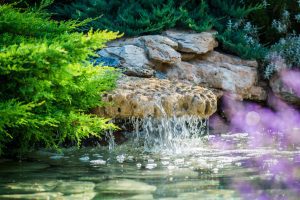
Why is There Foam on My Koi Pond? Understanding Causes and Solutions
Foam on a koi pond can be a puzzling sight for pond owners. This frothy substance often appears on the water’s surface, leaving many to wonder about its cause and potential impact on their beloved fish.

The presence of foam in a koi pond typically indicates an excess of organic matter in the water. This organic material can come from various sources, including fish waste, decaying plants, and uneaten fish food. As these substances break down, they release proteins and other compounds that create bubbles when agitated by water movement.
While a small amount of foam is generally harmless, larger quantities may signal an imbalance in the pond ecosystem. It’s important for koi keepers to monitor foam levels and take appropriate steps to maintain a healthy environment for their fish. Regular pond maintenance and proper filtration can help reduce foam and ensure optimal water quality for koi.
Identifying Pond Foam
Pond foam can appear for various reasons in koi ponds. Recognising its characteristics and common sources helps pond owners address the issue effectively.
Characteristics of Pond Foam
Koi pond foam often looks like a frothy layer on the water’s surface. It can be white, off-white, or light brown in colour. The foam may form in patches or cover large areas of the pond. It tends to gather at the edges or in corners where water movement is less.
Bubbles in the foam can vary in size. Some may be tiny and tightly packed, while others are larger and more spread out. The foam’s texture can range from light and airy to dense and sticky.
Surface tension plays a role in foam formation. It allows bubbles to cluster together and persist on the water’s surface. Wind and water movement can cause the foam to shift and change shape.
Common Sources of Foam
Excess proteins in the water are a frequent cause of koi pond foam. These proteins can come from fish waste, uneaten fish food, or decaying plant matter. When these substances break down, they release proteins that create bubbles on the surface.
Algae blooms can also lead to foam formation. As algae grow and die off, they release organic compounds that contribute to foaming. This is more common in ponds with high nutrient levels.
Some pond treatments and medications can cause temporary foaming. This is usually harmless and should disappear once the treatment is complete.
Causes of Foam in Koi Ponds

Foam in koi ponds can appear for several reasons. These include the build-up of organic waste, excess nutrients, and fish activities.
Organic Waste Accumulation
Organic matter is a common cause of foam in koi ponds. Fish waste, fallen leaves, and dead plant material break down over time. This process releases proteins and other compounds into the water.
When these substances mix with air bubbles, they create foam. The more organic waste present, the more foam you’ll see on the surface.
Regular pond cleaning helps reduce this problem. Remove dead leaves and excess plant matter promptly. Use a net or skimmer to clear debris from the water surface.
Excess Nutrients and Overfeeding
Too many nutrients in the water can lead to foam formation. Overfeeding is a major culprit. Uneaten food sinks and decays, adding extra nutrients to the pond.
These nutrients fuel algae growth. As algae die off, they release substances that contribute to foam.
To prevent this:
- Feed fish only what they can eat in 5 minutes
- Remove any leftover food after feeding
- Use high-quality food to reduce waste
Spawning and Fish Activity
Koi spawning can cause temporary foam in ponds. During breeding, fish release proteins and other substances into the water. These mix with air and create foam.
Increased fish activity also stirs up the water. This mixes air with organic compounds already present, forming more foam.
This type of foam usually clears up on its own after spawning ends. It’s a natural process and not harmful to the fish.
Impact on Water Quality

Foam on a koi pond often signals changes in water quality. These changes can affect the health and wellbeing of koi fish. Water quality and foam presence are closely linked.
Importance of Water Quality for Koi Health
Koi need clean water to thrive. Good water quality helps koi breathe easily and keeps their immune systems strong. Poor water can make koi sick or stressed.
Key factors in water quality include:
- Ammonia levels (should be near zero)
- Nitrite levels (should be near zero)
- Nitrate levels (below 40 ppm is best)
- pH (7.0 to 8.6 is ideal)
- Dissolved oxygen (5-6 ppm or higher)
Regular testing helps spot problems early. Koi owners should check these levels weekly. Quick action can prevent fish illness when levels are off.
Correlation Between Foam and Water Conditions
Foam often means there’s too much organic matter in the water. This can come from:
- Uneaten fish food
- Fish waste
- Dead plants or algae
As this matter breaks down, it can:
- Raise ammonia levels
- Lower oxygen levels
- Increase nitrates
These changes can harm koi health. The foam itself isn’t toxic, but it’s a sign of poor water quality.
Fixing the underlying issue will usually make the foam go away. This might mean:
- Cleaning the pond
- Improving filtration
- Reducing feeding
- Adding beneficial bacteria
Regular maintenance helps prevent foam and keeps water healthy for koi.
Pond Maintenance Practices
Proper pond upkeep is crucial for maintaining a healthy environment for koi fish. Regular care helps prevent foam buildup and other issues that can harm aquatic life.
Routine Water Changes
Water changes are essential for koi pond health. Replace 10-15% of the water weekly to remove waste and replenish minerals. Use a pump to remove old water and add fresh, dechlorinated water slowly.
Test water quality before and after changes. Aim for:
- pH: 7.0-8.6
- Ammonia: 0 ppm
- Nitrite: 0 ppm
- Nitrate: < 20 ppm
Clean debris from the pond surface with a net. This helps reduce organic matter that can lead to foam.
Pond Filter Systems
A good filter system is key to a clean koi pond. It removes waste and keeps water clear. There are three main types:
- Mechanical filters: Trap solid waste
- Biological filters: Break down harmful chemicals
- UV filters: Kill algae and bacteria
Clean or backwash filters regularly. How often depends on pond size and fish load. Check manufacturer guidelines for your specific system.
Replace filter media as needed. Old media can harbour bacteria and reduce efficiency.
Skimmer Utilisation
Skimmers are vital for surface cleaning. They collect floating debris before it sinks and decays. Install a skimmer at the pond’s edge where wind blows debris.
Empty skimmer baskets daily during peak seasons. Clean the pump and check for clogs weekly. Trim plants near the skimmer to prevent blockages.
In winter, remove or cover skimmers to prevent freezing. Use a pond de-icer to keep a hole in the ice for gas exchange.
Addressing Foam Buildup
Foam buildup in koi ponds can be tackled through proper cleaning, ecosystem balance, and targeted treatments. These approaches help maintain a healthy environment for your fish.
Effective Pond Cleaning Techniques
Regular cleaning is crucial for reducing foam. Start by removing debris with a net or skimmer. This prevents organic matter from breaking down and causing foam.
Use a pond vacuum to clean the bottom. Focus on areas where waste accumulates. Be gentle to avoid disturbing beneficial bacteria.
Clean filters regularly. Rinse them in pond water to preserve good bacteria. Replace filter media as needed.
Consider a protein skimmer. It removes dissolved organic compounds that contribute to foam. Install it in your filtration system for best results.
Balancing the Pond Ecosystem
A balanced ecosystem helps prevent foam naturally. Add plants like water lilies and hornwort. They absorb excess nutrients and provide oxygen.
Introduce beneficial bacteria. These microorganisms break down waste and reduce foam-causing compounds.
Maintain proper fish levels. Overstocking leads to excess waste and foam. Follow the rule of 1 inch of fish per 10 gallons of water.
Test water parameters regularly. Keep pH between 7.0 and 8.0. Maintain ammonia and nitrite at 0 ppm, and nitrate below 40 ppm.
Treatment and Prevention Methods
Use de-foaming agents sparingly. They offer quick fixes but don’t address the root cause.
Improve water circulation. Add air stones or fountains to increase oxygen levels. This helps break down organic matter.
Install a UV steriliser. It kills algae and harmful bacteria that can contribute to foam.
Perform partial water changes weekly. Replace 10-15% of pond water with fresh, dechlorinated water.
Consider biological filtration upgrades. Larger or more efficient filters can handle waste better, reducing foam buildup.
Health and Diet of Koi
Koi fish need proper nutrition and care to stay healthy. The right diet and feeding habits impact both the fish and their pond environment.
Proper Feeding Regimen
Koi should be fed 2-4 times daily when water temperatures are above 10°C. Give them only what they can eat in 5 minutes. In colder months, reduce feedings as fish become less active.
Choose high-quality koi food pellets as the main diet. These contain balanced nutrients for growth and health. Supplement with fresh foods like lettuce, oranges, and watermelon as treats.
Avoid overfeeding, as uneaten food can pollute the pond. Remove leftovers promptly to maintain water quality.
Significance of Koi Nutrition on Pond Conditions
A proper diet keeps koi healthy and affects pond health too. Well-fed koi produce less waste, which helps maintain clean water.
Nutrient-rich foods can lead to excess algae growth if uneaten. This causes foam and poor water quality. Balance feedings with pond size and fish numbers.
Good nutrition boosts koi immune systems. This helps them fight off illnesses that could spread in the pond. Healthy koi also create less stress on filtration systems.
Use foods with lower phosphorus content to reduce algae issues. This can help prevent foam and keep the pond clearer.
Monitoring and Testing Pond Water
Regular water testing is crucial for maintaining a healthy koi pond. It helps spot problems early and keeps the water safe for fish.
Utilising Water Testing Kits
Pond water test kits are essential tools for koi keepers. These kits measure key parameters like pH, ammonia, nitrite, and nitrate levels. Most kits use colour-changing strips or liquid reagents. To use them:
- Collect a water sample from the pond
- Add the test solution or dip the strip
- Compare the result to a colour chart
For accuracy, test at the same time each day. Keep a log of results to track changes over time. Some advanced kits can also measure dissolved oxygen and phosphate levels.
Regular Assessment of Water Parameters
Checking water conditions often helps prevent issues before they harm fish. Test weekly or more if you spot problems. Key things to monitor:
- pH: Aim for 7.0 to 8.6
- Ammonia: Should be 0 ppm
- Nitrite: Keep at 0 ppm
- Nitrate: Below 40 ppm is best
If levels are off, take action quickly. This might mean doing water changes or adjusting filtration. In summer, test more often as warm water can change faster.
Advanced Filtration Solutions
Modern koi pond filters use advanced technologies to remove foam and improve water quality. These systems target specific pollutants and enhance the natural filtration processes in ponds.
Protein Skimmers and Surfactants
Protein skimmers are powerful tools for foam removal in koi ponds. They work by creating tiny bubbles that attract dissolved organic compounds and surfactants. As the bubbles rise, they collect these substances and push them into a collection cup. This process effectively removes foam-causing agents from the water.
Surfactants are a key cause of foam in ponds. These molecules have one end that’s attracted to water and another that repels it. This property allows them to create bubbles easily. Protein skimmers target these surfactants, pulling them out of the water before they can form foam.
Enhancing Biological Filtration
Biological filtration is crucial for breaking down waste in koi ponds. Advanced systems boost this process by providing more surface area for beneficial bacteria to grow. These bacteria consume ammonia and nitrites, which can contribute to foam formation.
Some modern filters use special media that increase the pond’s bio-load capacity. This means the pond can handle more fish waste without issues. Fluidised beds are one example of this technology. They keep filter media in constant motion, allowing water to flow freely through it.
Another approach is using UV sterilisers alongside biological filters. UV light kills algae and harmful bacteria, reducing organic matter in the water. This lessens the workload on the biological filter and helps prevent foam buildup.
Environmental Considerations and External Factors
Koi pond foam can be influenced by various environmental factors and outside elements. These include natural processes like algal growth and the presence of wildlife, as well as changes in weather and climate.
Algal Blooms and Their Impact
Algal blooms can play a big role in foam formation on koi ponds. These blooms happen when algae grow quickly in warm, nutrient-rich water. As algae grow and die, they release substances that can create foam.
Blooms also increase the amount of dissolved organic carbon in the water. This can make foam more likely to form and last longer. High fish loads can make algal blooms worse by adding more nutrients to the water.
Sometimes, microorganisms that feed on algae can also contribute to foam. They release waste products that act like soap in the water.
Dealing with Wildlife and Climatic Influences
Wildlife can affect foam levels in koi ponds. Birds and animals may bring in extra nutrients when they visit. This can feed algae and lead to more foam.
Weather changes can also impact foam formation. Heavy rain can wash pollutants into the pond. This adds more stuff that can create foam. Strong winds can whip up the water surface, making existing foam spread out more.
Hot weather can speed up algae growth and make foam problems worse. Cold snaps might kill off some algae, releasing more foam-causing substances into the water.
Seasonal changes in plant growth around the pond can affect nutrient levels too. This can indirectly influence foam production throughout the year.



